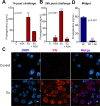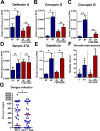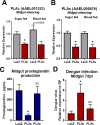Prostaglandins regulate humoral immune responses in Aedes aegypti
- PMID: 33095767
- PMCID: PMC7584201
- DOI: 10.1371/journal.pntd.0008706
Prostaglandins regulate humoral immune responses in Aedes aegypti
Abstract
Prostaglandins (PGs) are immuno-active lipids that mediate the immune response in invertebrates and vertebrates. In insects, PGs play a role on different physiological processes such as reproduction, ion transport and regulation of cellular immunity. However, it is unclear whether PGs play a role in invertebrate's humoral immunity, and, if so, which immune signaling pathways would be modulated by PGs. Here, we show that Aedes aegypti gut microbiota and Gram-negative bacteria challenge induces prostaglandin production sensitive to an irreversible inhibitor of the vertebrate cyclooxygenase, acetylsalicylic acid (ASA). ASA treatment reduced PG synthesis and is associated with decreased expression of components of the Toll and IMD immune pathways, thereby rendering mosquitoes more susceptible to both bacterial and viral infections. We also shown that a cytosolic phospholipase (PLAc), one of the upstream regulators of PG synthesis, is induced by the microbiota in the midgut after blood feeding. The knockdown of the PLAc decreased prostaglandin production and enhanced the replication of Dengue in the midgut. We conclude that in Ae. aegypti, PGs control the amplitude of the immune response to guarantee an efficient pathogen clearance.
Conflict of interest statement
The authors have declared that no competing interests exist.
Figures





Similar articles
-
Dengue virus inhibits immune responses in Aedes aegypti cells.PLoS One. 2010 May 18;5(5):e10678. doi: 10.1371/journal.pone.0010678. PLoS One. 2010. PMID: 20502529 Free PMC article.
-
Microbiota activates IMD pathway and limits Sindbis infection in Aedes aegypti.Parasit Vectors. 2017 Feb 23;10(1):103. doi: 10.1186/s13071-017-2040-9. Parasit Vectors. 2017. PMID: 28231846 Free PMC article.
-
Emerging role of lipid droplets in Aedes aegypti immune response against bacteria and Dengue virus.Sci Rep. 2016 Feb 18;6:19928. doi: 10.1038/srep19928. Sci Rep. 2016. PMID: 26887863 Free PMC article.
-
Roles of prostaglandins in immunosuppression.Clin Immunol. 2024 Aug;265:110298. doi: 10.1016/j.clim.2024.110298. Epub 2024 Jun 22. Clin Immunol. 2024. PMID: 38909972 Review.
-
Prostaglandins in Marine Organisms: A Review.Mar Drugs. 2019 Jul 23;17(7):428. doi: 10.3390/md17070428. Mar Drugs. 2019. PMID: 31340503 Free PMC article. Review.
Cited by
-
Immune Reactions of Vector Insects to Parasites and Pathogens.Microorganisms. 2024 Mar 12;12(3):568. doi: 10.3390/microorganisms12030568. Microorganisms. 2024. PMID: 38543619 Free PMC article. Review.
-
Non-immune Traits Triggered by Blood Intake Impact Vectorial Competence.Front Physiol. 2021 Mar 2;12:638033. doi: 10.3389/fphys.2021.638033. eCollection 2021. Front Physiol. 2021. PMID: 33737885 Free PMC article. Review.
-
Evolution of the Major Components of Innate Immunity in Animals.J Mol Evol. 2024 Feb;92(1):3-20. doi: 10.1007/s00239-024-10155-2. Epub 2024 Jan 28. J Mol Evol. 2024. PMID: 38281163 Review.
-
Eicosanoid Signaling in Insect Immunology: New Genes and Unresolved Issues.Genes (Basel). 2021 Feb 1;12(2):211. doi: 10.3390/genes12020211. Genes (Basel). 2021. PMID: 33535438 Free PMC article. Review.
-
Aedes mosquitoes in the emerging threat of urban yellow fever transmission.Rev Med Virol. 2022 Jul;32(4):e2333. doi: 10.1002/rmv.2333. Epub 2022 Feb 6. Rev Med Virol. 2022. PMID: 35124859 Free PMC article. Review.
References
-
- Destephano DB, Brady UE, Woodall LB. Partial characterization of prostaglandin synthetase in the reproductive tract of the male house cricket, Acheta domesticus. Prostaglandins. 1976;11(2):261–73. Epub 1976/02/01. . - PubMed
Publication types
MeSH terms
Substances
Grants and funding
LinkOut - more resources
Full Text Sources

